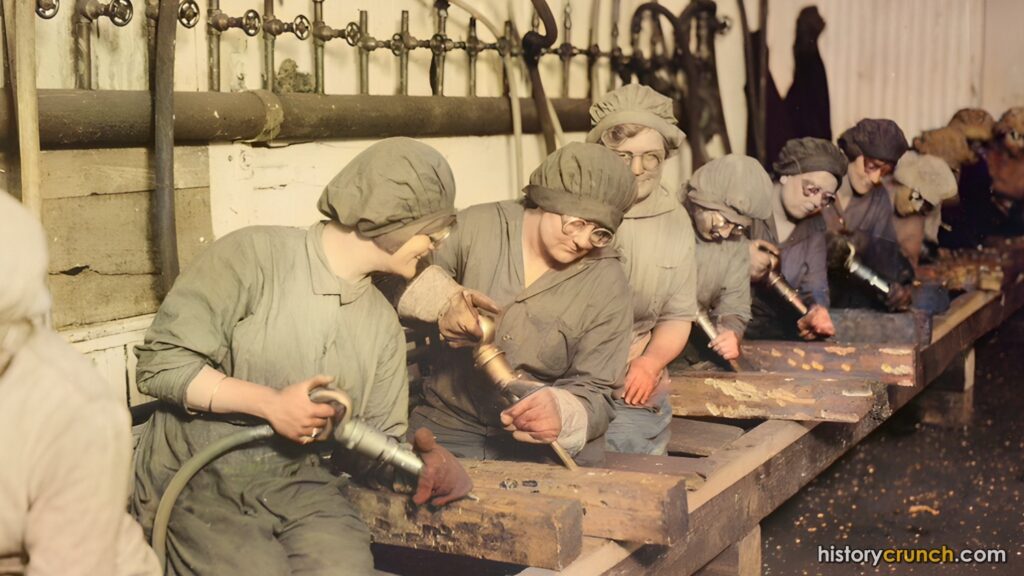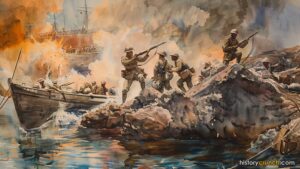Women played an important role in the events of World War I. For instance, World War I brought about significant changes in society and gender roles, as women across the globe stepped into new roles and made considerable contributions to the war effort. This article investigates the role of women in World War I, drawing examples from various countries including Australia, Britain, Canada, France, Germany, Russia and the United States.
ROLE OF WOMEN IN WORLD WAR I – WORKFORCE
One of the primary ways that the role of women changed in World War I was their entry into the workforce. Prior to World War I, most jobs, especially manufacturing jobs, were completed by men. However, with the start of the First World War, men from many countries were either conscripted to go to war or volunteered. As such, this created a need for a new workforce, which paved the way for women to enter workplaces that they had previously never been.
More specifically, in Britain, Canada, and the United States, women entered the workforce in large numbers to fill roles traditionally held by men who were fighting in the war. They worked in munitions factories, producing weapons, ammunition, and equipment essential for the war effort.

This was an incredibly important change for the lives of many American women, because before the start of World War I most women did not work outside of the home. Not only, were many women working for the first time, but they were also working in jobs that were generally employed by men. This included jobs in heavy industry, manufacturing, police, firefighters, etc. This was the first time in American history that American women had worked in many of these positions and in such large numbers. The contributions of women in these roles was significant as it helped maintain American society at a difficult time while also supplying the necessary resources for the war.

ROLE OF WOMEN IN WORLD WAR I – NURSING
Women also served as nurses and medical personnel on the front lines and in field hospitals, providing essential care to wounded soldiers. In Australia and Britain, organizations like the Voluntary Aid Detachments (VADs) and the Australian Army Nursing Service (AANS) recruited and trained women to serve as nurses. These women displayed bravery and compassion in the face of adversity, often working under harsh conditions and risking their lives to save others.
In the United States, over 21,000 American women served as nurses in the United States Army during World War I. They often served near the battlefields and were important in aiding injured soldiers on the front lines of battle.

ROLE OF WOMEN IN WORLD WAR I – MILITARY
For the most part, women did not serve in direct fighting roles in the militaries of World War I. However, that does not dims their contributions to the overall war effort. For instance, in Germany, women served in auxiliary roles such as clerks, telegraph operators, and ambulance drivers, freeing up men for combat duties.
As well, in the United States, more than 13,000 American women enlisted in the United States Navy. They were primarily posted in positions in the United States and helped with duties toward the war effort. As well, 450 served as switchboard operators in the Signal Corps Female Telephone Operators Unit. They relayed messages and were bilingual in both English and French. At the time, they were known as the ‘Hello Girls’ by soldiers.

In Russia, women played significant roles in supporting the military effort, including serving as soldiers, pilots, and combat medics. The Women’s Battalion of Death, formed in Russia in 1917, was composed entirely of female soldiers who fought on the front lines alongside men.

ROLE OF WOMEN IN WORLD WAR I – THE HOME FRONT
Women on the home front played vital roles in supporting the war effort through various activities such as fundraising, rationing, and volunteering. In France, women were actively involved in relief work, providing aid to soldiers and civilians affected by the war. In Australia, women participated in patriotic fundraising campaigns and knitted socks, scarves, and other essentials for soldiers serving overseas.
In Canada, the Canadian government created initiatives to control the production and use of resources to ensure that as many resources were being put towards the war effort as possible. For example, citizens on the home front (primarily women) were required to ration food items and other resources in order to make them for use on the frontlines.

ROLE OF WOMEN IN WORLD WAR I – THE RIGHT TO VOTE
World War I also proved important for the women’s suffrage movement (right to vote) in many countries. Before World War I, women across much of Europe and North America were unable to vote. However, the contributions of women during the war, along with the increased political activism led to changes that ultimately resulted in many women gaining the right to vote for the first time.
In Britain, the war helped advance women’s suffrage, with the Representation of the People Act of 1918 granting voting rights to certain women. In America, the contributions of women to the war effort played a significant role in securing the passage of the 19th Amendment in 1920, granting women the right to vote.
In Canada, Canadian women in Manitoba, Saskatchewan, and Alberta gained the right to vote in 1916. Finally in 1918, the federal government of Canada granted full voting rights (suffrage) to all women in Canada. The women’s suffrage movement in Canada occurred at roughly the same time as similar suffrage movement in other countries, such as Britain and the United States.




